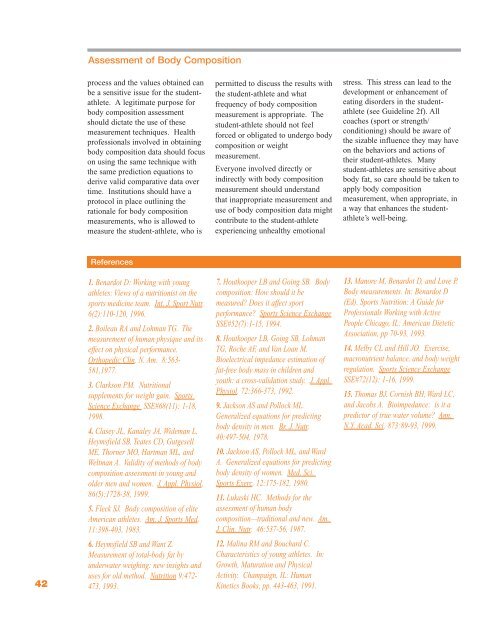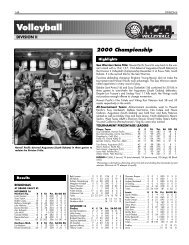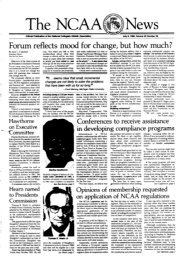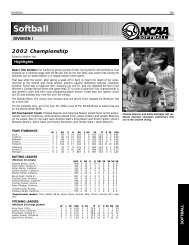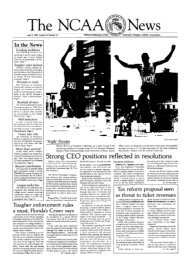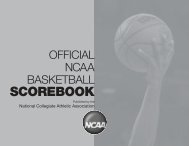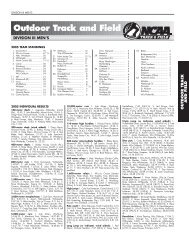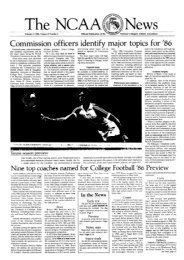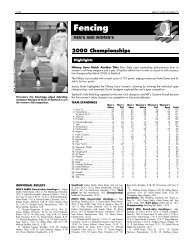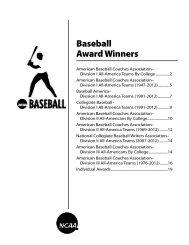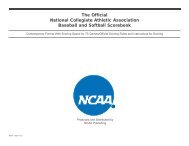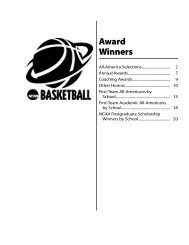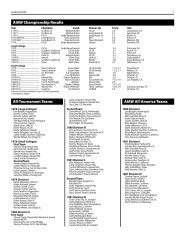Sports Medicine Handbook - NCAA
Sports Medicine Handbook - NCAA
Sports Medicine Handbook - NCAA
Create successful ePaper yourself
Turn your PDF publications into a flip-book with our unique Google optimized e-Paper software.
42<br />
Assessment of Body Composition<br />
process and the values obtained can<br />
be a sensitive issue for the studentathlete.<br />
A legitimate purpose for<br />
body comp osition assessment<br />
should dictate the use of these<br />
measurement techniques. Health<br />
professionals involved in obtaining<br />
body composition data should focus<br />
on using the same technique with<br />
the same prediction equations to<br />
derive valid comparative data over<br />
time. In stitutions should have a<br />
protocol in place outlining the<br />
rationale for body composition<br />
measurements, who is allowed to<br />
measure the student-athlete, who is<br />
References<br />
1. Benardot D: Working with young<br />
athletes: Views of a nutritionist on the<br />
sports medicine team. Int. J. Sport Nutr.<br />
6(2):110-120, 1996.<br />
2. Boileau RA and Lohman TG. The<br />
measurement of human physique and its<br />
effect on physical performance.<br />
Orthopedic Clin. N. Am. 8:563-<br />
581,1977.<br />
3. Clarkson PM. Nutritional<br />
supplements for weight gain. <strong>Sports</strong><br />
Science Exchange SSE#68(11): 1-18,<br />
1998.<br />
4. Clasey JL, Kanaley JA, Wideman L,<br />
Heymsfield SB, Teates CD, Gutgesell<br />
ME, Thorner MO, Hartman ML, and<br />
Weltman A. Validity of methods of body<br />
composition assessment in young and<br />
older men and women. J. Appl. Physiol.<br />
86(5):1728-38, 1999.<br />
5. Fleck SJ. Body composition of elite<br />
American athletes. Am. J. <strong>Sports</strong> Med.<br />
11:398-403, 1983.<br />
6. Heymsfield SB and Want Z.<br />
Measurement of total-body fat by<br />
underwater weighing: new insights and<br />
uses for old method. Nutrition 9:472-<br />
473, 1993.<br />
permitted to discuss the results with<br />
the student-athlete and what<br />
frequency of body composition<br />
measurement is ap propriate. The<br />
student-athlete should not feel<br />
forced or obligated to undergo body<br />
composition or weight<br />
measurement.<br />
Everyone involved directly or<br />
indirectly with body composition<br />
measurement should understand<br />
that inappropriate measurement and<br />
use of body composition data might<br />
contribute to the student-athlete<br />
experiencing unhealthy emotional<br />
7. Houtkooper LB and Going SB. Body<br />
composition: How should it be<br />
measured? Does it affect sport<br />
performance? <strong>Sports</strong> Science Exchange<br />
SSE#52(7):1-15, 1994.<br />
8. Houtkooper LB, Going SB, Lohman<br />
TG, Roche AF, and Van Loan M.<br />
Bioelectrical impedance estimation of<br />
fat-free body mass in children and<br />
youth: a cross-validation study. J. Appl.<br />
Physiol. 72:366-373, 1992.<br />
9. Jackson AS and Pollock ML.<br />
Generalized equations for predicting<br />
body density in men. Br. J. Nutr.<br />
40:497-504, 1978.<br />
10. Jackson AS, Pollock ML, and Ward<br />
A. Generalized equations for predicting<br />
body density of women. Med. Sci.<br />
<strong>Sports</strong> Exerc. 12:175-182, 1980.<br />
11. Lukaski HC. Methods for the<br />
assessment of human body<br />
composition—traditional and new. Am.<br />
J. Clin. Nutr. 46:537-56, 1987.<br />
12. Malina RM and Bouchard C.<br />
Characteristics of young athletes. In:<br />
Growth, Maturation and Physical<br />
Activity. Champaign, IL: Human<br />
Kinetics Books, pp. 443-463, 1991.<br />
stress. This stress can lead to the<br />
development or enhancement of<br />
eating disorders in the studentathlete<br />
(see Guideline 2f). All<br />
coaches (sport or strength/<br />
conditioning) should be aware of<br />
the sizable influence they may have<br />
on the behaviors and actions of<br />
their student-athletes. Many<br />
student-athletes are sensitive about<br />
body fat, so care should be taken to<br />
apply body composition<br />
measurement, when appropriate, in<br />
a way that enhances the studentathlete’s<br />
well-being.<br />
13. Manore M, Benardot D, and Love P.<br />
Body measurements. In: Benardot D<br />
(Ed). <strong>Sports</strong> Nutrition: A Guide for<br />
Professionals Working with Active<br />
People Chicago, IL: American Dietetic<br />
Association, pp 70-93, 1993.<br />
14. Melby CL and Hill JO. Exercise,<br />
macronutrient balance, and body weight<br />
regulation. <strong>Sports</strong> Science Exchange<br />
SSE#72(12): 1-16, 1999.<br />
15. Thomas BJ, Cornish BH, Ward LC,<br />
and Jacobs A. Bioimpedance: is it a<br />
predictor of true water volume? Ann.<br />
N.Y. Acad. Sci. 873:89-93, 1999.


